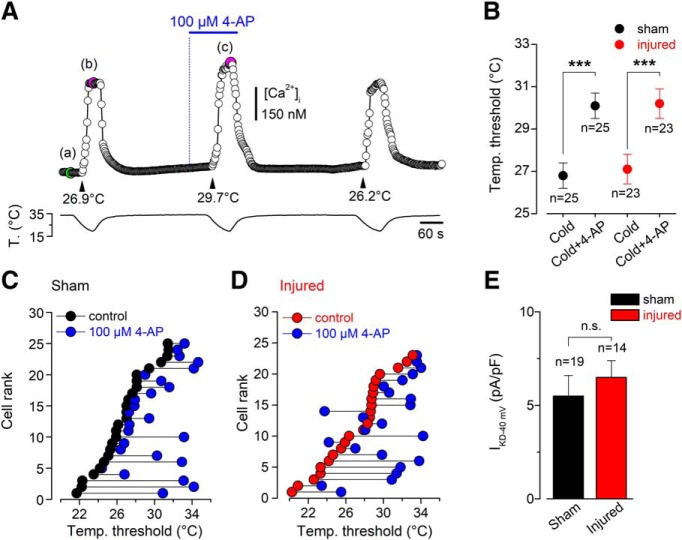Figure 5.
Effect of pharmacological suppression of IKD on the thermal threshold of CCSNs from sham and injured mice. A, [Ca2+]i response in a representative CCSN from a sham animal during three consecutive cooling stimuli, in control solution (first and third pulses) and in the presence of 100 μm 4-AP (second pulse). The cold threshold of this neuron was shifted to higher temperatures by 4-AP, from 26.9 to 29.7°C (black arrowheads). The green dot in Aa indicates the basal level of [Ca2+]i and the magenta dots in Ab and Ac indicate the maximal responses to cold in control and 4-AP conditions. Note the reversibility of the 4-AP-dependent effect. B, Mean values of temperature threshold of CCSNs from control (black dots) and injured (red dot) mice in control conditions and in the presence of the inhibitor of IKD (4-AP). Note that the mean shift of the thermal threshold of both populations of CCSNs by the suppression of IKD was similar. Temperature threshold shifts after treatment with 4-AP in both populations were assessed using paired Student's t test: t(24) = 4.614, ***p = 0.0001 and t(22) = 4.077, ***p = 0.0005, respectively. C, D, Effect of 100 μm 4-AP on temperature threshold of cold-evoked responses in 25 CCSNs from sham group and 23 CCSNs from injured animals, displayed individually according to the initial cold threshold from highest to lowest. The thermal threshold under 100 μm 4-AP is represented by blue circles. E, Bar plot summarizing the mean IKD current density at −40 mV in sham (black, n = 19) and injured (red, n = 14) CCSNs (t(31) = 0.6132, n.s. p = 0.5442, unpaired t test).

